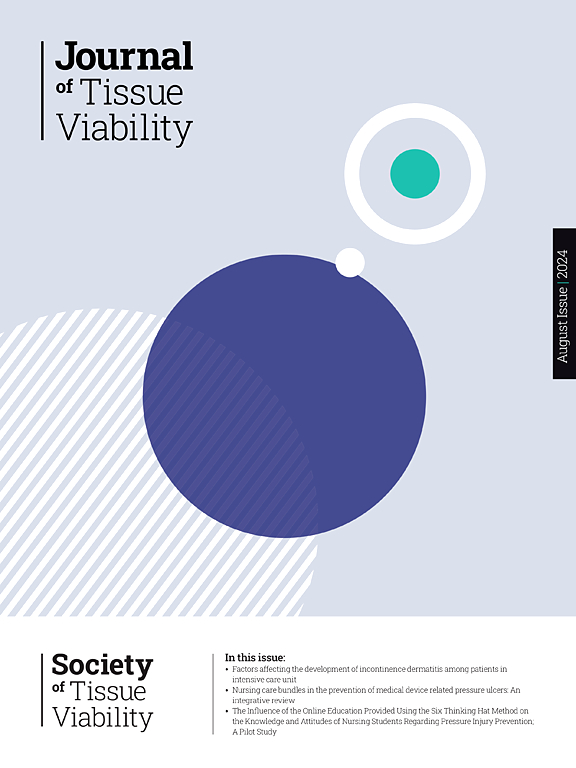The ‘HAPI’ project five years on: Incidence and prevalence of Hospital-Acquired Pressure Injuries in one local health district in Australia
IF 2.4
3区 医学
Q2 DERMATOLOGY
引用次数: 0
Abstract
Aim
From 2015 to 2018, the ‘Hospital-Acquired Pressure Injury (HAPI)’ project was implemented in one local health district in Australia and utilised an implementation science approach to address rising pressure injury (PI) incidence and prevalence rates. This paper aims to examine whether the project was successful in sustaining low PI incidence and prevalence rates over the five-years following implementation (spanning the 2018/2019 to 2022/2023 financial years and the 2019–2023 calendar years).
Materials and methods
A retrospective cohort study was conducted involving a comprehensive analysis of HAPI incidence, prevalence, and hospital-acquired complication (HAC) data spanning 5 years (incidence and HAC: 2018/2019 to 2022/2023 financial years; prevalence: January 2019 to December 2023 calendar years) post-implementation of the HAPI project.
Results
Since 2018/2019, incidence of HAPIs decreased by 32.6 % (30.7 HAPI per 10,000 episodes of care in 2018/2019 vs 20.7 HAPI per 10,000 episodes of care in 2022/2023 financial year), prevalence remained stable from 1.1 % to 1.27 % (2019 vs 2023 calendar year), and HAC pressure injuries (stage III, IV, suspected deep tissue, unspecified or unstageable) declined by 27.3 % (2.2 HAPI per 10,000 episodes of care in 2018/2019 vs 1.6 HAPI per 10,000 episodes of care in 2022/2023 financial year).
Conclusion
The HAPI project has successfully maintained a low incidence and prevalence rate of HAPI, over 5 years following implementation. This achievement highlights the benefits of utilising an implementation science approach to implementing a multi-faceted intervention in a complex healthcare setting to ensure sustainability beyond the project phase.
“HAPI”项目五年以来:澳大利亚一个地方卫生区医院获得性压力伤害的发生率和流行率。
目的:从2015年到2018年,“医院获得性压力伤害(HAPI)”项目在澳大利亚的一个地方卫生区实施,并利用实施科学方法来解决不断上升的压力伤害(PI)发病率和患病率。本文旨在研究该项目是否成功地在实施后的五年内(2018/2019至2022/2023财政年度和2019-2023日历年)保持了较低的PI发病率和患病率。材料和方法:进行了一项回顾性队列研究,全面分析了HAPI的发病率、患病率和医院获得性并发症(HAC)数据,时间跨度为5年(发病率和HAC: 2018/2019至2022/2023财政年度;患病率:HAPI项目实施后的2019年1月至2023年12月。结果:自2018/2019以来,哈皮神的发病率下降了32.6%(每10000集30.7哈皮神的护理在2018/2019 vs 20.7哈皮神每10000集保健在2022/2023财政年度),发病率保持稳定从1.1%到1.27% (2019 vs 2023日历年),和HAC压力伤害(阶段III, IV,疑似深层组织,不明或unstageable)下降了27.3%(每10000集2.2哈皮神的护理在2018/2019 vs 1.6哈皮神每10000集保健在2022/2023财政年度)。结论:HAPI项目实施5年多来,成功地保持了HAPI的低发病率和患病率。这一成就突出了利用实施科学方法在复杂的医疗保健环境中实施多方面干预的好处,以确保项目阶段之后的可持续性。
本文章由计算机程序翻译,如有差异,请以英文原文为准。
求助全文
约1分钟内获得全文
求助全文
来源期刊

Journal of tissue viability
DERMATOLOGY-NURSING
CiteScore
3.80
自引率
16.00%
发文量
110
审稿时长
>12 weeks
期刊介绍:
The Journal of Tissue Viability is the official publication of the Tissue Viability Society and is a quarterly journal concerned with all aspects of the occurrence and treatment of wounds, ulcers and pressure sores including patient care, pain, nutrition, wound healing, research, prevention, mobility, social problems and management.
The Journal particularly encourages papers covering skin and skin wounds but will consider articles that discuss injury in any tissue. Articles that stress the multi-professional nature of tissue viability are especially welcome. We seek to encourage new authors as well as well-established contributors to the field - one aim of the journal is to enable all participants in tissue viability to share information with colleagues.
 求助内容:
求助内容: 应助结果提醒方式:
应助结果提醒方式:


